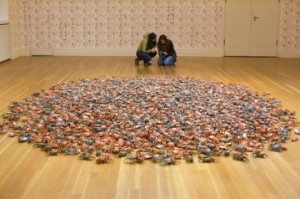July 23, 2014
Thoughts on the artist’s one-man exhibition in Berlin.
Ai Weiwei He Xie
Ai Weiwei’s piece ‘He Xie’ at the Martin-Gropius-Bau in Berlin. Photo provided by Tienchi Martin-Liao.
The largest one-man exhibition of Ai Weiwei’s artwork ended this week in Berlin’s Martin-Gropius-Bau. During the past three months visitors have been impressed by his creative, bold, and indicative manner of artistic expression. The exhibition hall’s 3000 square meters housed 34 new pieces, several huge installations, photos, and videos that are the artist’s call for dialogue and mutual understanding between himself and the viewers. Throughout the exhibit one can feel the artist’s tension and explosive strength, even though he was absent from the proceedings.
Though Ai is not in jail, he cannot leave China and come to his own exhibition. He can move “freely,” yet he’s always under surveillance and tailed by a bunch of police. However, the government’s pressure and suppression seems to be one of the most important sources of ideas and emotional inspiration for him. Without “big brother” watching, threatening, harassing, and conducting sabotage Ai would probably only be half as good, and half as successful. Really, the story of Ai Weiwei and his fight sounds like a paranoid tragic-comedy.
The problem with contemporary art is that most artists are trying to see things from a twisted new perspective, and record it in an absurd, sensational form. It infrequently imparts any outstanding thoughts nor ideas. No wonder this kind of art generates no resonance among its viewers. However, Ai is different. He is a great artist who knows how to reproduce the anxiety, humiliation, anger, and fear he suffers daily as a dissident-artist and he knows how to use his work to transfer these genuine feelings and complex circumstances to viewers.
The title of his Berlin exhibition is “Evidence.” Showing evidence not in court but in a museum, through aesthetic artworks one can trace back to the thoughts of the artist. In this, Ai has picked up prominent political and social topics from Chinese society and presented them in a provocative and humorous way. For example, hundreds of porcelain river crabs (hexie) piled on the ground coincide with the Beijing government’s hypocritical slogan of “social harmony” (hexie). In fact, in November 2010 Ai invited hundreds of neighbors to his Shanghai workshop for a “crab-eating party,” but, because of police intervention, the party certainly didn’t take place under harmonious circumstances.
A year after the earthquake in Sichuan, where nearly 70,000 thousand people died, a large part of them school children, Ai hosted an exhibition in Munich where 8,738 school bags were hung to symbolize and memorialize the number of students who were killed in the earthquake. Before the exhibition, Ai went to the site of the catastrophe in Chengdu, where he helped victims and gathered materials. While he was there, he was taken to a police station and beaten up by several policemen. With a head wound he still flew to Munich for the opening of his exhibition. If the German physicians had delayed performing the surgery Ai could’ve died of of a brain hemorrhage.

